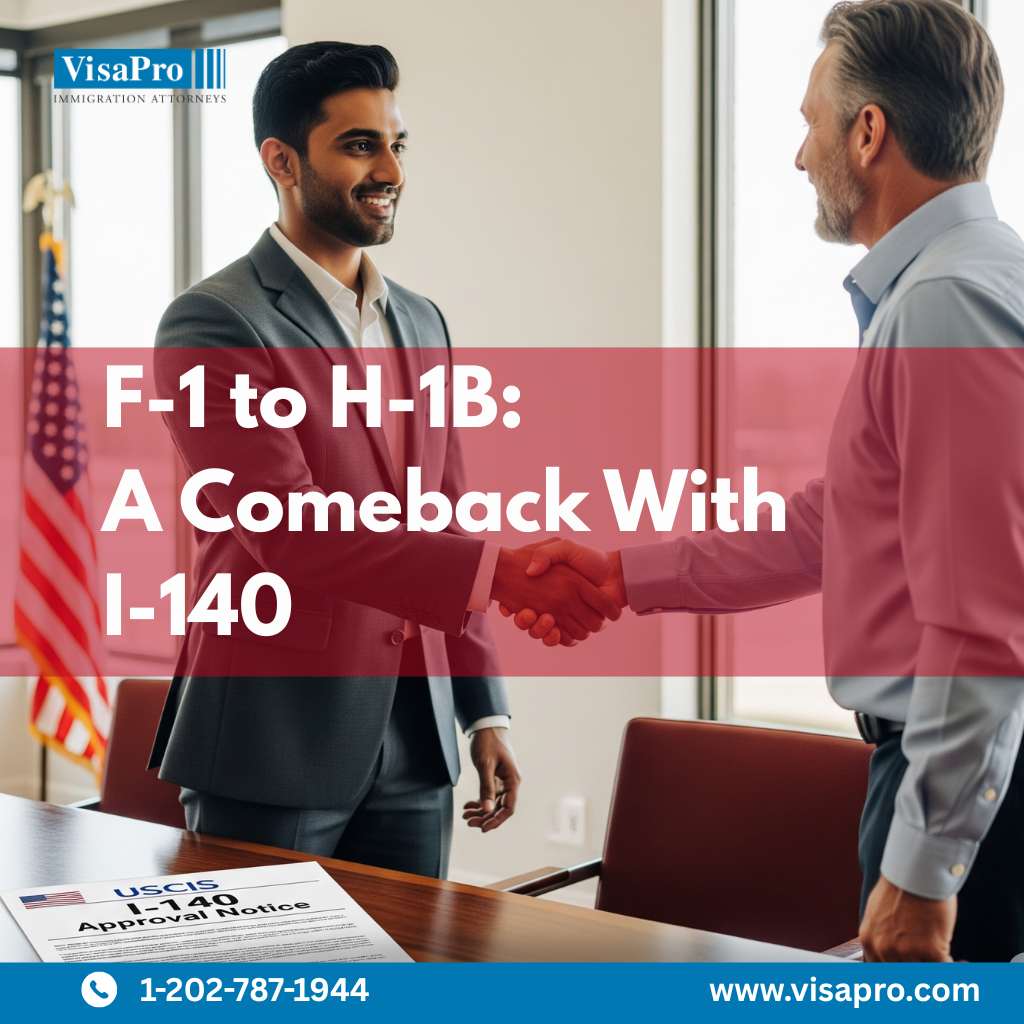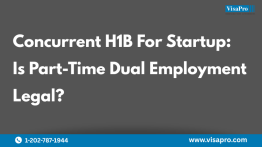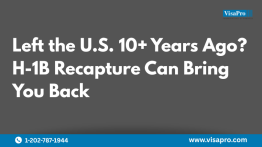Quick Summary:
If you’ve been laid off near the end of your 6-year H-1B limit and don’t have an approved I-140, the situation can feel overwhelming. But you’re not out of options. This guide explains how switching to F-1 status, and later back to H-1B, can give you a second chance. Learn real strategies, legal timelines, and how VisaPro can help you protect your future in the U.S.
Understanding Your Options When You’re Laid Off Near the H-1B 6-Year Limit
Clear Answer:
If you’re laid off with months left of your H-1B time, you may be hard-pressed to find an employer to transfer H-1B as you do not have enough time to restart the green card process to get an H-1B extension. Changing status to F-1 student visa may be viable option to lawfully remain in the U.S. and preserve a path to return to H-1B.
When the H-1B clock is running out and you get laid off, it’s a race against time. If your I-140 is not yet approved, or worse, your PERM is still in process, staying in the U.S. lawfully becomes complicated. Many professionals assume they must leave the country. But changing status from H-1B to F-1 (especially with Curricular Practical Training or CPT eligibility) can provide lawful stay, work authorization, and a way to restart your green card process with a new employer.
Real Scenario Example:
An H-1B software engineer with only 3 months remaining on his 6-year cap was laid off before his I-140 could be filed. Rather than leave the U.S., he quickly enrolled in a Master’s program offering. The program also offered the opportunity to do CPT. This option gave him legal status and allowed him to work for a new employer who later restarted his PERM and I-140 process.
What Happens to Your Green Card Process After a Layoff During PERM or I-140?
Clear Answer:
If you’re laid off during the PERM or I-140 stage, most employers will immediately stop the green card process. Without an approved I-140, you cannot extend H-1B beyond 6 years.
This is one of the most common, and painful setbacks for H-1B professionals. If your PERM is pending, it is employer-specific and cannot transfer. An I-140 must be approved (and ideally 180 days old) to give you future flexibility. When you’re laid off:
- If PERM is still in progress: You must start over with a new employer
- If I-140 is filed but not approved: You must start over with a new employer unless the employer agrees to continue the process
- If I-140 is approved and less than 180 days old: You may port to a new job and extend H-1B beyond 6 years as long as employer does not revoke the I-140
- If I-140 is approved and more than 180 days old: You may port to a new job and extend H-1B beyond 6 years, and you are eligible to continue using that approved I-140 to extend your H-1B (until your priority date becomes current).
Tip:
Try to negotiate with your former employer to continue the I-140 process even after your layoff. Some employers are open to this, especially if you were a key contributor and the cost of continuing is minimal.
Changing Status From H-1B to F-1: Why It’s a Lifeline for Many
Clear Answer:
You can apply for a change of status from H-1B to F-1 inside the U.S. if you are still within your grace period or remaining H-1B time. Approval is not guaranteed, but F-1 provides a legal bridge and may include CPT/OPT benefits.
When you’re facing the end of your H-1B period, the change of status from H-1B to F-1 can keep you in status, buy you time, and even open work authorization via CPT or OPT. However, this strategy must be executed carefully:
- Enroll in a SEVP-approved school
- File change of status before your 60-day grace period (or remaining H-1B time) ends.
- Prepare a solid academic and immigration intent statement to support approval
- Look for schools that offer flexible CPT options
Real Scenario Example:
A laid-off H-1B engineer with no I-140 filed was accepted into an MBA program that allowed immediate CPT. Within weeks, he was in valid F-1 status. He later found a new job and resumed employment legally and was able to restart the PERM process with a new company, eventually returning to H-1B using an approved I-140.

H-1B to F-1 to H-1B: A Valid Loop Back to Employment
Clear Answer:
Yes, you can switch from H-1B to F-1, then return to H-1B status through cap-exempt extension (if I-140 is approved) or a fresh H-1B filing if you’re eligible for a new cap lottery.
This “loop” is a strategy used by many professionals caught in layoffs or green card delays. Here’s how it typically works:
- Change status from H-1B to F-1, remain in the U.S. legally
- Begin studying
- Get hired by a new employer who starts PERM and I-140 and work in the meantime with CPT and/or OPT
- Once I-140 is approved, reapply for H-1B beyond 6 years
Important Tip:
If you’ve exhausted all H-1B time and have no I-140, you’ll need to leave the U.S. for at least 1 year to qualify for a fresh H-1B under the cap, unless you bridge with F-1 status and gain work authorization.
Dealing With H-1B Layoffs After I-140 Approval: What You Can Still Use
Clear Answer:
If you were laid off with an approved I-140, you may still be able to extend H-1B beyond 6 years, even if you switch employers, depending on how long ago the I-140 was approved.
This is one of the most misunderstood parts of immigration. Even after a layoff, an approved I-140 gives you:
- The ability to extend H-1B in 3-year increments until your priority date becomes current
- Retention of your priority date for future green card filings.
However, your employer can withdraw the I-140. If it’s been less than 180 days since approval, USCIS will likely revoke it and you lose the benefit of the extension beyond the 6th year. If it’s been over 180 days, you retain your priority date and ability to extend the H-1B beyond 6 years.
F-1 With CPT or OPT: Can It Keep You Working While You Restart Green Card Process?
Clear Answer:
Yes, F-1 status with CPT or OPT lets you work legally while a new employer begins your PERM and I-140 process. This is a practical option when H-1B is no longer viable.
Many H-1B holders don’t realize that F-1 with CPT or OPT can be a powerful bridge. It’s not a long-term solution, but it buys you the time to reset your green card path.
Checklist To Use F-1 CPT or OPT Strategically:
- Choose a school that offers immediate or early CPT
- Ensure CPT or OPT is related to your degree field
- If you do utilize less than 1 year of full-time CPT, you may be eligible for post-completion OPT and/or STEM OPT
- Start PERM process within months of employment
- File I-140 quickly to regain H-1B eligibility after 6-year cap
Keyword Use: f1 to h1b visa, h1b to f1 to h1b
Best Next Steps After Layoff With Months Left on H-1B
Clear Answer:
Act immediately. Explore F-1 change of status, consult with employers about continuing PERM/I-140, and contact a qualified immigration attorney to create a long-term plan.
Action Plan:
- Use your 60-day grace period wisely
- Enroll in a school with CPT or OPT options
- File COS to F-1 before H-1B time ends
- Get hired under CPT or OPT
- Restart green card process with new employer
- Return to H-1B status based on approved I-140
Real Client Outcome:
A marketing manager with 2 months left on H-1B shifted to an F-1 program, used OPT to work full-time, and completed her I-140 within 18 months, regaining H-1B and eventually securing a green card.
Frequently Asked Questions (FAQ)
1.What are my options if I’m on H-1B with I-140 approved and get laid off?
If your I-140 was approved over 180 days ago, you can retain your priority date and extend H-1B with a new employer. If it’s less than 180 days, you may lose the ability to extend your H-1B beyond 6 years your employer doesn’t withdraw it immediately.
2.Can I apply for a change of status from H-1B to F-1 after a layoff?
Yes, but you must still be in valid status or within the 60-day grace period. Approval is not guaranteed, so apply early and choose a credible academic program.
3.What happens to PERM if I’m laid off?
The PERM process ends if you’re laid off and the employer does not continue it. It is employer-specific and cannot be transferred. You must restart the PERM process with a new sponsor.
The original priority date of the I-140 can also be ported to the EB-1C petition, accelerating the process.
4.Can I work on F-1 status while waiting for my green card process to restart?
Yes, if your program allows CPT or OPT. This work must be related to your field of study, and your employer should initiate the PERM and I-140 early during this time.
5.How do I return to H-1B after switching to F-1?
Once your I-140 is approved, your new employer can file an H-1B extension beyond 6 years. If no I-140, you may need to leave the U.S. for 1 year and re-enter under a new H-1B lottery.
Need Help Navigating This Complex Process?
Your career and future in the U.S. don’t have to end with a layoff. VisaPro has helped hundreds of professionals successfully shift to F-1, restart green cards, and return to H-1B. Contact us today for a free assessment, let’s build your comeback plan together.
What VisaPro Customers Are Saying
The US [B-1] Visa has always been a tough ride, and being denied a few times it makes it even worse. But thanks to VisaPro and their meticulous processing I was granted a Visa. I would like to thank you and all the people involved in making this a success. I would like to recommend VisaPro to all those who seek peace of mind and hassle free Visa processing.”




 Manas Bhat, Director Operations, First Houston Mortgage India
Manas Bhat, Director Operations, First Houston Mortgage India



